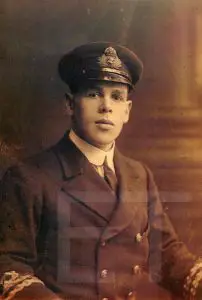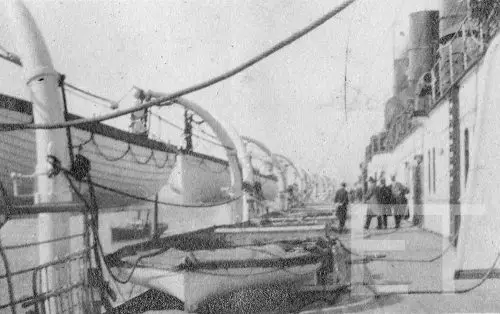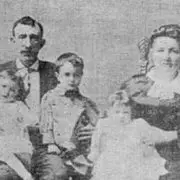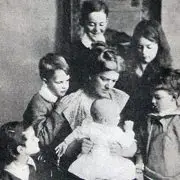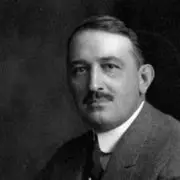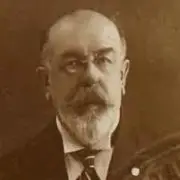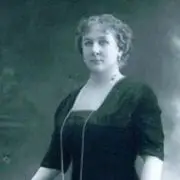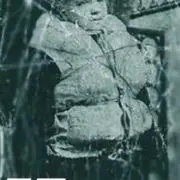Lest We Forget : Albert Arthur Bestic
“To me she was my dream ship. I saw her first when in her regal beauty she sped along the surface of the Clyde upon her trials. My boyish heart went out to her in admiration.”
That was Albert Arthur Bestic’s first impression upon seeing the new Lusitania. The next time he saw her, he was on a small windjammer. As he looked up at the liner, he saw, “a photographic impression of four big funnels, tiers of decks, fluttering handkerchiefs, the name ‘Lusitania‘ in gold letters, and a roaring bow wave.” When the ship “streaked by”, it created a large wave that sent all the men into the lee scuppers. The sailors began cursing at her, but not Bestic. He vowed one day that he would stand upon the bridge of that ship!
Bestic itself is not a name of Irish origin. The branch that Albert descended from was originally from the Huguenot French in the Normandy region of France. He was the second child of Arthur and Sarah Stephenson, born on August 26, 1890. He had an older sister Olive who was born in 1888. The family resided in Donnybrook, Dublin South. His father was a banker and a wood worker. He was educated at the Portsmouth Grammar School and the St. Andrew’s School.
The sea called to Bestic in 1908 and he joined the sailing ship, Denbigh Castle, of the Robert Thomas & Co, as an apprentice. It sailed from Cardiff, Wales and it’s destination was Peru. As soon as he was aboard, he was told his new nickname would be ‘Paddy’ as he was from Dublin. Very much the novice, he nearly strangled the Captain with the rope from the ship’s flags by making as he called it, ‘a slippery hitch.’ Although he expected the worse, the Captain took pity and the punishment was minimal. The ship, which was delivering patent fuel, had a treacherous crossing. The Denbigh Castle suffered many storms and at one point a sailor on board said that Davy Jones had been “foiled again”. It was feared lost until it finally sailed into Fremantle, Australia and proceeded to it’s final destination of Peru. It had taken well over a year to get there. This did not deter Bestic and he continued to work his way up. He also became acquainted with Annie Queenie Elizabeth Kent, originally of Belfast but living in England. They continued their courtship and were married in early 1915.
“To me she was my dream ship. I saw her first when in her regal beauty she sped along the surface of the Clyde upon her trials. My boyish heart went out to her in admiration.”
He sailed to the US as an officer aboard the Leyland liner, Californian. To his great surprise, he was informed that his next assignment would be as the junior third officer of the Lusitania– his dream ship! Ironically, the next name after Bestic on the seaman’s discharge book that also lists substitutes engaged was David Craig McCormick, who was became the Lusitania’s junior telegraphist. Looking around at his new surroundings, he thought to himself, “Would not fate put me in command of her someday?”
Quick introductions were made to his fellow officers. He found Staff Captain Jock Anderson to be friendly and that put him at ease. First officer Arthur Rowland Jones of Flintshire had a “grim” appearance, but was most likely concerned with duties that needed to be done. His relaxation was perusing his five volumes by Conrad in his cabin. Percy Hefford, like himself had only been recently married. One bit advice he was given was to avoid socializing too much with the passengers, especially the ladies.
The boat drill was held but as he later noted, his lifeboats were not lowered due to a coal barge directly underneath them. The ship set sail and the junior third officer settled into his duties which included, his watches on the bridge, completing meteorological forms, the log book, late night tours with Hefford, and baggage room, which he detested. He was there to make sure nothing was “pilfered” while crew searched for a passengers trunk. His off duty activity was playing bridge in the officer’s smoke room with whichever officers might be available. He remembered one game being interrupted by a knock on the door. “The quartermaster appeared at the door with a four-stranded Turk’s Head in his hand. ‘Captain’s compliments and he says he wants another of these made.’ The bridge had to be stopped and we spent the rest… trying to remember how it was made.”
One night before the disaster always stuck out in his memory.
“Looking into the ballroom where dancing and gaiety held sway, my thoughts flew to that famous dance given by the Duchess of Richmond in Brussels on the eve of Waterloo… I still wonder if it was a premonition of disaster.”
The day of the disaster dawned and Bestic went about his duties. He was on the 8-to-12 watch and took the soundings due to the intense fog. He also telephoned down about the fire drill. Ex-Chief Stevens then took his place and Bestic left and had his lunch as always at 1 o’clock. Soon after, baggage master Crank came to him and informed him that, “he was about to get the baggage on deck preparatory for discharge on our arrival at Liverpool, and that already a working party awaited my arrival.” Realizing that he was in his good uniform, he went back to change into his old one that he used for such occasion. He had just finished and was in the officer’s smokeroom when the Lusitania was struck.
“I heard an explosion… and went out on the bridge and I saw the track of the torpedo. It seemed to be fired in line with the bridge and it seemed to strike the ship between the second and third funnels as far as I could see… the possibility of the Lusitania being doomed never entered my head. A crippled engine maybe, followed by a limp into Queenstown would be, to my mind, the climax of disaster. Then inexorably, the facts were forced into my brain. The heavy list, the settling down by the bows… I heard the order, ‘hard-a-starboard’ and I heard Captain Turner saying, ‘lower the boats down to the level of the rail and I went to my section of boats… My section was from 2 to 10.”
Researchers have relied on a book that purports to quote Bestic as having said that the list caused the lifeboats on the portside to drop onto the deck and slide down towards the bow. The effect of this was leaving bloody and broken bodies in their wake. However, reading through Bestic’s testimony and many accounts that he wrote- he never said such a thing. Whether he added this to his MS, ‘Waveswept‘ or authors added this to add to the story is unclear. As it stands, no chaos like that ever occurred on the ship.
Staff Captain Anderson was by Bestic’s side trying to assist in getting the boats away. They were trying to lower boat 10, but it didn’t quite make it over the side of the deck. “Captain Anderson was beside me and he said, ‘Go to the bridge and tell them they are to trim her with the port tanks.’ I made my way to the bridge and sung out that order to Mr. Hefford, the second officer. He repeated it and came back again and no. 10 boat was on the deck. We tried to push it out but could not.” He later noted that when trying to lower the port boats they would scrape down the side of the “sloping hull” rendering them unseaworthy.
“A dreadful cry arose which chilled my heart and blood. I turned rapidly and looked aft. The stern of the mighty vessel had risen out of the water. Like a flash I whipped around. The bow was gone.” Peering over the side, he saw that the boat deck was only a few feet above water. He stepped over the side, with no lifebelt, and began swimming away. Thinking he had escaped, he found him self being drawn down in a “hole” in the ocean. He was going downward and downward in the whirlpool. Finally, he felt the suction had ceased and he began his swim upwards. He broke the surface, but was briefly pulled back down again by a drowning person. The next time he came up he cracked his head. Unable to sea, he wondered if he was blind, but soon realized he was underneath an upturned boat. Diving downwards, he came up alongside the boat and was pulled in by a crewman named Quinn. No sooner did he began to get his bearings, he realized many people were trying to clamber aboard. The craft was in danger of sinking, so he took to the water again. Using a side stroke, he took off and swam right into a collapsible. It was awash, but nearby he found some floating water tanks to help the buoyancy of his refuge. “I knew I was saved.”
He helped rescue other people from the water and a few hours later was picked up by the trawler Bluebell. He soon found himself face-to-face with Captain Turner. Their encounter was brief and the officer congratulated his captain on his escape. Turner, in his gruff way, turned to Bestic, whom he always called Bisset, said, “You aren’t that fond of me.” Bestic was back in his native land, but under tragic circumstances. The return was short and soon he was back in England preparing for his testimony before Lord Mersey. They questioned him on the seaworthiness of the lifeboats. Although he said he checked the gear, he was unaware of the condition of the boats themselves. This put the Lusitania behind him for the time being.
A year after the sinking, his wife gave birth to their first child, Desmond Arthur. The war was raging and Bestic was serving in the Royal Navy aboard minesweepers. He suffered a few losses when his mother died in 1917 and his sister ran away with a boy she met at college when both families disapproved of the match. They disappeared without a trace, much to his regret. His second son, George Stephenson was born in Scotland in 1919. His career at sea continued as a captain of several relief vessels with the Commissioners of Irish Lights. His last child, Alan Kent was born in 1922 in Richmond. The Lusitania was never far from his mind and in 1932, the Railey expedition contacted him to join them to explore the wreck. Unfortunately, it never really went anywhere. However, a few years later, a Captain Henry Russell financed by the Argonaut Corporation invited him and fellow survivor Robert Chisholm to join him in exploring the wreck. He joined the expedition as chief officer aboard the ship, Orphir. He noted there would be a number of false trails, but he was confident that Lusitania would be located using Cunard data, Captain Turner’s notes and his own memories. They were using a new marconi detecting device that would aid them in finding her. Remarkably, he predicted that since the ship would be on it’s side, due the pressure it would be somewhat flattened. The Orphir encountered such a horrific storm that Bestic ordered the wireless operator to prepare to send a message. Visibility was non-existant and huge green waves washed over the decks. The howling wind increased as it whipped through the mast and roared down the ventilators. As it was twenty years ago, the former Lusitania officer was in charge of the port side boats and ordered his crew to stand-by. Heading back to Kinsale, they had a near collision with a Dutch boat, Parnevele, when it crossed the Orphir’s bows.
The divers would be Jim Jarrett and Ernest Pope. A reporter, Gilbert McAllister, on board the expedition described the diving gear as “weirder than Frankenstein”. The news that traveled back home fascinated people. Survivor Robert Timmis was now blind, but listened to daily radio reports of the expedition while, Lady Rhondda declared she would like to dive to the Lusitania herself. A barrister named James Burke was interviewed as he had seen the Lusitania sink from the shore. His room-mate at University College, Cork was Dr. McDermott who was drowned. He added the curious fact that the locals refused to eat fish for over a year as the fish had been “feeding” off the Lusitania victims.
The expedition turned perilous as Jim Jarrett was diving. An anchor was caught by the currents and flung against his suit, just missing the glass of his helmet. He was raised back to the surface after his near-death experience, but soon asked to try again. Sadly, in the midst of the expedition, Bestic was fired by the owners as he refused to give up his book rights. He went ashore in September of 1935. Finally, in October, the ship was believed to be found. The new chief officer Horn requested that the Orphir of 500 yeards out of its limits, “just for luck”. The able seaman at the helm soon shouted, “There’s something Sir.” The graph showed an outline of a large shipwreck. Jarrett finally dove to the wreck, he saw painfully little due to limited visibility, but had the remarkable experience of walking across the liner’s “slime covered plates”. Though the ship had been located, dreams of finding and recovering gold supposedly aboard the sunken vessel were unrealistic and the expedition was ended.
Bestic kept himself busy, and in an exclusive interview he wrote for the New York Times, he talked with Captain William Turner aboard their experiences aboard the shipwreck. Turner was “certain” the ship was struck twice and said there was no gold, but “alot of money and jewelry in the pursers safes.”
He found his former commander to have the same “alertness of manner and the same quick penetrating look in his sharp blue eyes. But his quarterdeck manner had softened considerably.” He also wrote that Turner said he was “distinctly worried” about being torpedoed on that voyage. Bestic made the error of saying he was the only surviving officer, which prompted a newspaper rebuttal by the senior third officer, John Idwal Lewis.
A final near disaster nearly killed Bestic. He was serving as commander aboard the Light ship Isolda when in December 1940, she was bombed and sunk. Six men were killed, but not Bestic. Poor vision and a touch of heart trouble forced him to retire from the sea and he found himself writing more articles as a new career. He helped Adolph Hoehling with certain details of the 1915 shipwreck, for a book called, Last Voyage of the Lusitania. His own book about his adventures aboard the Denbigh Castle called, Kicking Canvas was published a few years later and was well received. He now lived in Bray and was considered a local authority on the sea. He also wrote an article about a documentary he was involved with regarding the Light exploration of the Lusitania. It also became a reunion of several survivors, some of whom he had not seen since 1915. It was entitled, So I Shall See the Lusitania Again. He was finally able to see footage of his lost “dream ship.” As Christmas time approached, Bestic took ill and passed away on December 20, 1962. He was buried in family vault in St. Michan’s Parish Church in Dublin.
Photo of Albert Bestic courtesy of his descendants.
Photo of Lusitania boat deck (1915) courtesy of Michael Poirier.

